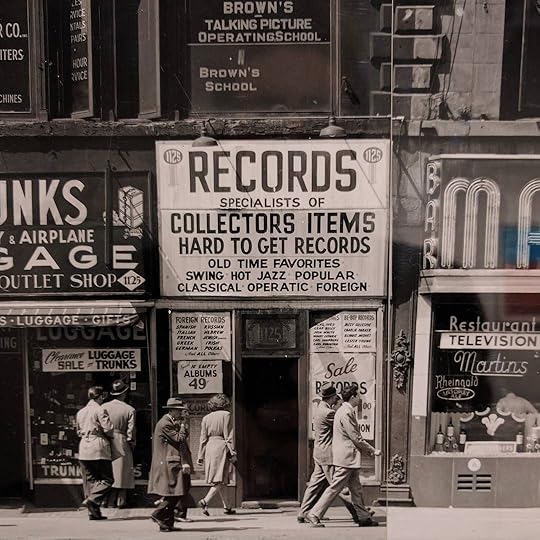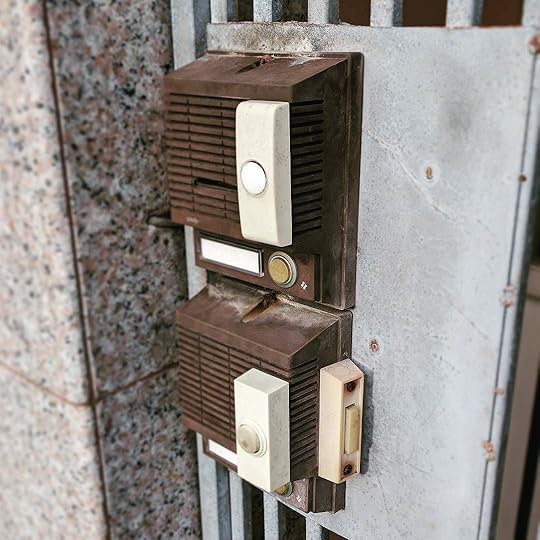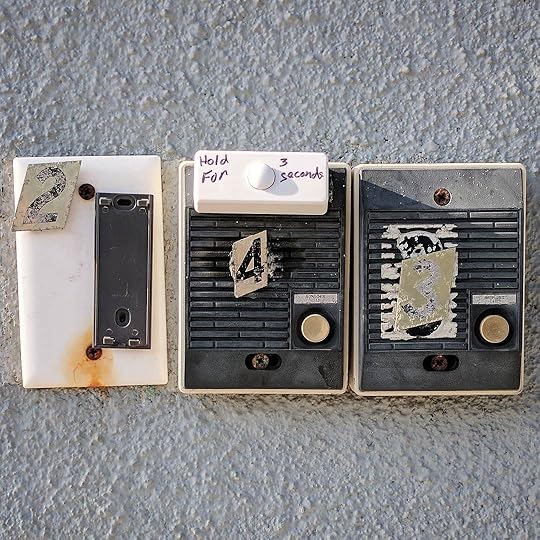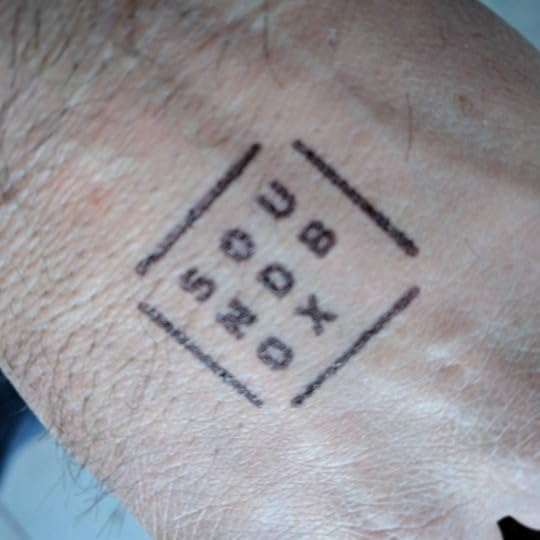Marc Weidenbaum's Blog, page 308
April 27, 2017
Disquiet Junto Project 0278: MacConnel’s Jingle

Each Thursday in the Disquiet Junto group, a new compositional challenge is set before the group’s members, who then have just over four days to upload a track in response to the assignment. Membership in the Junto is open: just join and participate. A SoundCloud account is helpful but not required. There’s no pressure to do every project. It’s weekly so that you know it’s there, every Thursday through Monday, when you have the time.
This project’s deadline is 11:59pm wherever you are on Monday, May 1, 2017. This project was posted in the mid-afternoon, California time, on Thursday, April 27, 2017.
These are the instructions that went out to the group’s email list (at tinyletter.com/disquiet-junto):
Disquiet Junto Project 0278: MacConnel’s Jingle
The Assignment: Interpret a work of contemporary art as a graphically notated score.
Step 1: The image at the following URL is a photograph of Jingle, a 1980 work by the artist Kim MacConnel (b. 1946). The piece, which is approximately 8 feet wide and is made of acrylic on cotton, hangs at the Parrish Art Museum in the town of Watermill, New York, on the east end of Long Island.
http://disquiet.com/wp-content/uploads/2017/04/kimmacconneljingle.jpg
Step 2: Compose a short piece of music that interprets MacConnel’s Jingle as a graphically notated score.
Five More Important Steps When Your Track Is Done:
Step 1: If you hosting platform allows for tags, be sure to include the project tag “disquiet0278″ (no spaces) in the name of your track. If you’re posting on SoundCloud in particular, this is essential to my locating the tracks and creating a playlist of them.
Step 2: Upload your track. It is helpful but not essential that you use SoundCloud to host your track.
Step 3: In the following discussion thread at llllllll.co please consider posting your track:
http://llllllll.co/t/disquiet-junto-project-0278-macconnels-jingle/
Step 4: Annotate your track with a brief explanation of your approach and process.
Step 5: Then listen to and comment on tracks uploaded by your fellow Disquiet Junto participants.
Deadline: This project’s deadline is 11:59pm wherever you are on Monday, May 1, 2017. This project was posted in the mid-afternoon, California time, on Thursday, April 27, 2017.
Length: The length is entirely up to the participant.
Title/Tag: When posting your track, please include “disquiet0278″ in the title of the track, and where applicable (on SoundCloud, for example) as a tag.
Upload: When participating in this project, post one finished track with the project tag, and be sure to include a description of your process in planning, composing, and recording it. This description is an essential element of the communicative process inherent in the Disquiet Junto. Photos, video, and lists of equipment are always appreciated.
Download: It is preferable that your track is set as downloadable, and that it allows for attributed remixing (i.e., a Creative Commons license permitting non-commercial sharing with attribution).
Linking: When posting the track online, please be sure to include this information:
More on this 278th weekly Disquiet Junto project — “MacConnel’s Jingle: Interpret a work of contemporary art as a graphically notated score” — at:
More on the Disquiet Junto at:
Subscribe to project announcements here:
http://tinyletter.com/disquiet-junto/
Project discussion takes place on llllllll.co:
http://llllllll.co/t/disquiet-junto-project-0278-macconnels-jingle/
There’s also on a Junto Slack. Send your email address to twitter.com/disquiet for Slack inclusion.
Image associated with this project is a photo of Kim MacConnel’s Jingle, a 1980 work for acrylic on cotton, shot at the Parrish Art Museum in Water Mill, New York, on the east end of Long Island.
April 23, 2017
What Sound Looks Like

Belated image for Record Store Day. This is a detail of a 1948 photo by Todd Webb (1905-2000) of 6th Avenue in Manhattan. The full image, a semi-panorama of sorts showing the complete block between 43rd and 44th Streets, including a second record store, is on display currently at the Curator Gallery on West 23rd as part of the exhibit Down Any Street: Todd Webb’s Photographs of New York, 1945-1960, curated by Bill Shapiro. Note the window advertisement above for Brown’s Talking Picture Operating School. That sharp line to the right of the store, between it and the bar newly listing “television” among its attractions, is a cut where two images were placed next to each other to allow Webb to achieve the effect of showing the entire stretch of 6th Avenue as if viewed from across the street.
An ongoing series cross-posted from instagram.com/dsqt.
April 21, 2017
What Sound Looks Like

People who try to express information on an XY grid eventually learn this lesson, often the hard way: sometimes the only option for accuracy is to access the third dimension. That realization was made, as well, by whoever was tasked at some point in the distant past with adding a fifth button (yes, fifth — note the semi-obscured circle at the bottom) to this already beleaguered assemblage. It’s unclear if this location is home to two or five individual addresses, or somewhere in between. The bottom set, if you perceive them as a set, could be three iterations of fixing a doorbell’s serial failures: first the main, boxy unit; then the second narrow sliver; then the side button. Then again these could be incremental sublets, the most recent an overpriced closet with the benefit of being near a major public transportation hub. The fact that none of the five buttons is labeled lends some mystery. While we may not know what the landlord is up to, clearly the next logical step is to go full tesseract.
An ongoing series cross-posted from instagram.com/dsqt.
April 20, 2017
Disquiet Junto Project 0277: Chew Concrète

Each Thursday in the Disquiet Junto group, a new compositional challenge is set before the group’s members, who then have just over four days to upload a track in response to the assignment. Membership in the Junto is open: just join and participate. A SoundCloud account is helpful but not required. There’s no pressure to do every project. It’s weekly so that you know it’s there, every Thursday through Monday, when you have the time.
Tracks will be added to this playlist for the duration of the project:
This project’s deadline is 11:59pm wherever you are on Monday, April 24, 2017. This project was posted in the morning, California time, on Thursday, April 20, 2017.
These are the instructions that went out to the group’s email list (at tinyletter.com/disquiet-junto):
Disquiet Junto Project 0277: Chew Concrète
The Assignment: Make music inspired by C. Reider’s Chew Cinders album procedures.
Step 1: This week’s project is inspired by the manner in which C. Reider recorded his recent album, Chew Cinders (Midnight Circles). We aren’t remixing his album. We’re remixing/repurposing his approach to the album. You can check it out here:
https://midnightcircles.bandcamp.com/album/chew-cinders
Step 2: This instruction is adapted, with Reider’s input, from the manner in which he recorded the album:
Process a sequence of standalone “chunks” of pre-recorded sound — voice, field recordings, noise — with an emphasis on the manipulation of time and pitch. Speed things up, slow them down, and explore the opportunity to use cutup techniques. Pay particular attention to segues between the chunks.
Step 3: Make a piece of music inspired by the approach delineated in Step 2.
Five More Important Steps When Your Track Is Done:
Step 1: If you hosting platform allows for tags, be sure to include the project tag “disquiet0277″ (no spaces) in the name of your track. If you’re posting on SoundCloud in particular, this is essential to my locating the tracks and creating a playlist of them.
Step 2: Upload your track. It is helpful but not essential that you use SoundCloud to host your track.
Step 3: In the following discussion thread at llllllll.co please consider posting your track:
http://llllllll.co/t/chew-some-concrete-sounds-disquiet-junto-project-0277/
Step 4: Annotate your track with a brief explanation of your approach and process.
Step 5: Then listen to and comment on tracks uploaded by your fellow Disquiet Junto participants.
Deadline: This project’s deadline is 11:59pm wherever you are on Monday, April 24, 2017. This project was posted in the morning, California time, on Thursday, April 20, 2017.
Length: The length is entirely up to the participant.
Title/Tag: When posting your track, please include “disquiet0277″ in the title of the track, and where applicable (on SoundCloud, for example) as a tag.
Upload: When participating in this project, post one finished track with the project tag, and be sure to include a description of your process in planning, composing, and recording it. This description is an essential element of the communicative process inherent in the Disquiet Junto. Photos, video, and lists of equipment are always appreciated.
Download: It is preferable that your track is set as downloadable, and that it allows for attributed remixing (i.e., a Creative Commons license permitting non-commercial sharing with attribution).
Linking: When posting the track online, please be sure to include this information:
More on this 277th weekly Disquiet Junto project — “Chew Concrète: Make music inspired by C. Reider’s Chew Cinders album procedures” — at:
More on the Disquiet Junto at:
Subscribe to project announcements here:
http://tinyletter.com/disquiet-junto/
Project discussion takes place on llllllll.co:
http://llllllll.co/t/chew-some-concrete-sounds-disquiet-junto-project-0277/
There’s also on a Junto Slack. Send your email address to twitter.com/disquiet for Slack inclusion.
Image associated with this project is adapted from the cover of the album that inspired the project, C. Reider’s Chew Cinders:
April 17, 2017
Brian Eno Gives the BBC a Studio Tour
“I’m trying to make a version of me in this software,” Brian Eno tells the BBC’s Spencer Kelly in a half-hour video from the broadcaster’s Click show. The ambient godfather is giving Kelly a tour of his studio, displaying how he constructs his light installations, his sculptures made of small speakers, and his software-based music. We see the dark backroom where he’s transitioned from cathode ray tubes to LEDs, and his ceiling-high bookshelves, 65 percent of which he estimates have science as their subject. Kelly, whose BBC reporting focus is technology, pushes Eno to confirm himself as something of a scientist, which Eno agrees to do.
Broadcasting is an odd thing. Kelly needs to ask a generalist’s questions, even though it’s clear he must know quite a bit more than he’s actually acknowledging knowledge of. They get around to “those cards,” which leads to a bit of a history lesson about how Roxy Music’s limited budget inspired Eno to get some best practices in order, which in turn became the Oblique Strategies deck. He also spends an extended bit making generative drum beats, and gives us a flip through old notebooks. Somewhere people with high-definition monitors are making and trading screenshots, no doubt.
There’s also fodder for an incredibly subtle animated GIF around the 18:23 mark, when Eno, his head emerging from a thick, collared overshirt like that of a tortoise, juts back and forth along to a semi-randomized rhythm he’s just implemented.
Found via synthtopia.com.
April 15, 2017
What Sound Looks Like

Some buildings are born as multi-unit dwellings. Others have multi-unit dwelling-ness thrust upon them. Amid that second subset are entrances that don’t live up to the challenge. This location has at least three additional addresses where there once was likely but a single residence. How you alert unit one to your arrival is unclear (since its button is missing entirely), as is how to access unit two (since its button is kaput). Adding to the mystery is the sequencing for units two, four, and three. The pièce de résistance isn’t the fact of that additional button for unit four, or even the quotidian instructions to “Hold for 3 seconds” (what happens if you hold longer?), or the readymade collage (RIP, James Rosenquist) where unit three’s identity is layered. It’s a one-two combo: First, how the “3 seconds” confuses the eye, carrying directly over from the 2 on the left, and briefly makes your brain think the center unit is, indeed, number three. Second, how the additional button for unit four is situated so as to serve as the noun in the instructional sentence — it’s virtually a doorbell emoji. As the shadows might suggest, this photograph was shot as the daylight was coming to an end, which seems appropriate to this location.
An ongoing series cross-posted from instagram.com/dsqt.
Musique Concrète + Video Games
This short documentary video about the making of the video game Resident Evil 7: Biohazard explores the use of musique concrète to achieve the game developers’ pursuit of a horror aesthetic. The 8-minute profile interviews various participants in the game’s production from a variety of sound roles, including audio director, composers, and music production supervisors.
Says one member of the team: “We talked about this whole musique concréte style. So using voices became part of the score, and we gave them instructions like pretend, you know, you’ve got a plastic bag over your head and you’re asphyxiating. Pretend you’re drowing; make a sound like that. By the end it got a little bit weird: you know, you’re a zombie cow and you’re dying.”
It’s interesting to observe their collective decision and their experience of moving away from traditional game music — which is generally electronic but also usually employs recognizably musical instrumentation or reference points — to work drawn entirely from recorded audio.
Video originally posted at Vimeo. More on the video game, which was released back in January, at residentevil7.com. An album of the music was also released in January: sumthing.com.
April 14, 2017
What Sound Looks Like

Finally making it. Should be a great evening.
An ongoing series cross-posted from instagram.com/dsqt.
Electromagnetic Ambient Music
These two short videos from Berlin-based musician Hainbach explore mangled ambience thanks to a handy new device that benefited from an especially popular Kickstarter campaign. The gadget in question is the KOMA Field Kit, and it serves as an entry point into various less typical sonic sources, including physical connections like solenoids and DC motors, as well as the far more ethereal electromagnetic pickup. The latter is employed in the first of these videos, “David Dreams | Tape, Field Kit, OP1, Phashi.” Watch as that little hand-held sensor is moved from one device to the next, the unique nature of its detection lending an otherworldly timbre to Hainbach’s drones. “Nevada in My Dreams | Tapeloop, Fieldkit, OP1” is even slower and doomier than “David Dreams,” with bits of radio noise shooting through like sliver glimpses of alternate worlds. Hainbach’s YouTube channel is a great source of electronic music using a variety of instruments, which he details in the notes associated with the videos. This pair investigates how two very different airborne signals can contribute to the texture of recordings.
Videos originally posted at Hainbach’s YouTube page. Hainbach is Berlin-based composer Stefan Paul Goetsch. More from Hainbach at hainbach.bandcamp.com and instagram.com/hainbach101. More on the KOMA Field Kit at cdm.link, which is where I first came across the “Nevada in My Dreams” video.
April 13, 2017
Disquiet Junto Project 0276: 808 Blockchain Beats

Each Thursday in the Disquiet Junto group, a new compositional challenge is set before the group’s members, who then have just over four days to upload a track in response to the assignment. Membership in the Junto is open: just join and participate. A SoundCloud account is helpful but not required. There’s no pressure to do every project. It’s weekly so that you know it’s there, every Thursday through Monday, when you have the time.
This project’s deadline is 11:59pm wherever you are on Monday, April 17, 2017. This project was posted in the morning, California time, on Thursday, April 13, 2017.
These are the instructions that went out to the group’s email list (at tinyletter.com/disquiet-junto):
Disquiet Junto Project 0276: 808 Blockchain Beats
The Assignment: Make 808-style beats based on the blockchain.
Many thanks to Jon Phillips for proposing and helping to develop this project.
Step 1: This week we’re making music informed and inspired by blockchain. If you’re not familiar with blockchain, this concise summary might be of use:
The Blockchain is a distributed database that maintains a continuously growing list of ordered records called blocks. Each block contains a timestamp and a link to a previous block. The most well known and original implementation is the Bitcoin Blockchain which is often described as a peer-to-peer (p2p) public ledger of all transactions. Blockchain technologies offer a consensus mechanism of indirect coordination, which provides the ability to achieve large-scale and systematic cooperation in an entirely distributed and decentralized manner. Blockchains can be considered as hyper-political and global governance tools, capable of managing social interactions on a large scale and dismissing traditional central authorities. Specific uses include accounting, identity management, record keeping systems,
voting, and land registries.
The source of the summary:
https://en.m.wikipedia.org/wiki/Blockchain
Now, if blockchain is too technical and you aren’t using bitcoin as the new gold ;) then use the images that come to mind: block & chain, and use 808 sounds to make some beats.
Step 2: Make a beat informed by blockchain that uses or is in someway inspired by the 808 drum machine.
Five More Important Steps When Your Track Is Done:
Step 1: If you hosting platform allows for tags, be sure to include the project tag “disquiet0276″ (no spaces) in the name of your track. If you’re posting on SoundCloud in particular, this is essential to my locating the tracks and creating a playlist of them.
Step 2: Upload your track. It is helpful but not essential that you use SoundCloud to host your track.
Step 3: In the following discussion thread at llllllll.co please consider posting your track:
http://llllllll.co/t/808-blockchain-beats-disquiet-junto-project-0276/
Step 4: Annotate your track with a brief explanation of your approach and process.
Step 5: Then listen to and comment on tracks uploaded by your fellow Disquiet Junto participants.
Deadline: This project’s deadline is 11:59pm wherever you are on Monday, April 17, 2017. This project was posted in the morning, California time, on Thursday, April 13, 2017.
Length: The length is entirely up to the participant.
Title/Tag: When posting your track, please include “disquiet0276″ in the title of the track, and where applicable (on SoundCloud, for example) as a tag.
Upload: When participating in this project, post one finished track with the project tag, and be sure to include a description of your process in planning, composing, and recording it. This description is an essential element of the communicative process inherent in the Disquiet Junto. Photos, video, and lists of equipment are always appreciated.
Download: It is preferable that your track is set as downloadable, and that it allows for attributed remixing (i.e., a Creative Commons license permitting non-commercial sharing with attribution).
Linking: When posting the track online, please be sure to include this information, and if possible link to the original track:
More on this 276th weekly Disquiet Junto project — “808 Blockchain Beats: Make 808-style beats based on the blockchain” — at:
More on the Disquiet Junto at:
Subscribe to project announcements here:
http://tinyletter.com/disquiet-junto/
Project discussion takes place on llllllll.co:
http://llllllll.co/t/808-blockchain-beats-disquiet-junto-project-0276/
There’s also on a Junto Slack. Send your email address to twitter.com/disquiet for Slack inclusion.
Image associated with this project is from:



